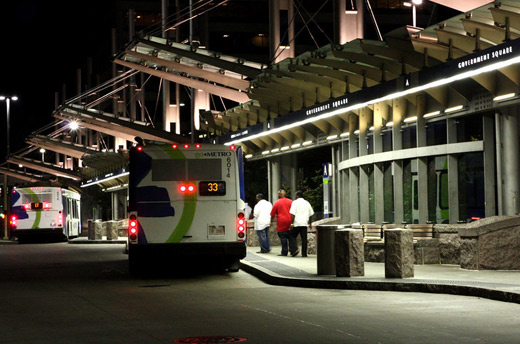
As local transit officials struggle to do more with less, leaders at the
Southwest Ohio Regional Transit Authority (SORTA) are examining how they might be able to restructure the Metro bus system to better serve Cincinnatians. The changes may mean that the decades old hub-and-spoke model may finally be on its way out of style.
"The hub-and-spoke model in Cincinnati is broken," exclaimed Colin Groth, Government Relations Director, Metro. "Right now, if you're trying to go from say Hyde Park to Westwood, you have to go Downtown first. This is a problem."
The problem is especially pronounced in Cincinnati due to its neighborhood orientation which lends itself to more hub-to-hub trips, rather than spokes leading to a singular hub. According to transportation experts, the solution seems to lie in an option that moves people from neighborhood hub to neighborhood hub.
The beginning of such a neighborhood hub bus system in Cincinnati will more than likely start by adding a second hub in Uptown, that will also serve as a facility for the
Cincinnati Streetcar, followed by neighborhood hubs in Northside and Walnut Hills.
"We have worked with neighborhoods and [transportation infrastructure consultant firm]
Parsons Brinckerhoff to figure out where people wanted to see Metro grow, and better access to Uptown and improved crosstown service were at the top of the list," Groth said.
Officials say that the goal is to eventually develop a collection of Neighborhood Transit Hubs that will serve as transfer points in the restructured system. The incremental changes will mean better service for riders within the city as they move from neighborhood to neighborhood, but it will also mean improved service for those traveling in traditional commuter patterns into Downtown and Uptown as buses will be able to travel in a more direct fashion.
What transit officials need now is money. The Uptown Neighborhood Transit Hub alone is estimated to cost approximately $6.2 million, but Metro officials are currently working with the
Uptown Consortium and the
Cincinnati Streetcar Development Partners to come up with the best plan for implementation. Design and engineering work is already underway and is expected to be complete within the next year, and construction will begin as funds are available.
In June, Metro received $11.77 million from the
OKI Regional Council of Governments through their allocations of two federal transportation programs. Some of this money will go towards the replacement of aging buses, but another chunk of the money will go toward this Neighborhood Transit Hub vision.
"The money is to develop the capital infrastructure to support both existing service as well as creating the building blocks for a more robust system down the road," Groth explained. "With more neighborhood hubs you can really facilitate center-to-center and neighborhood-to-neighborhood transportation - that's when you really begin to change the system."
Writer:
Randy A. SimesPhotography by Tiffani FisherStay connected by following Randy on Twitter
@UrbanCincy
Enjoy this story?
Sign up for free solutions-based reporting in your inbox each week.